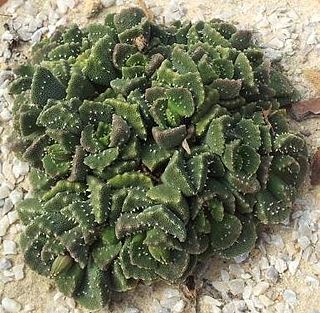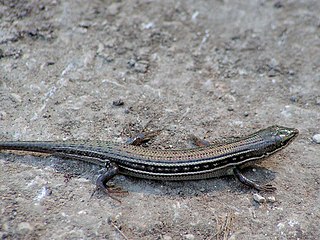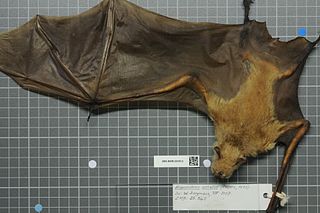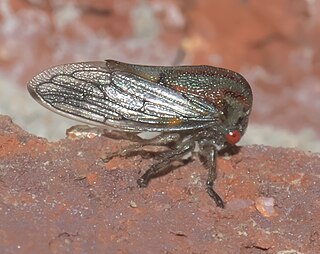
The Puerto Rican amazon, also known as the Puerto Rican parrot or iguaca, is the only extant parrot endemic to the archipelago of Puerto Rico, and belongs to the Neotropical genus Amazona. Measuring 28–30 cm (11.0–11.8 in), the bird is a predominantly green parrot with a red forehead and white rings around the eyes. Its closest relatives are believed to be the Cuban amazon and the Hispaniolan amazon.

Aloinopsis is a genus of ice plants from South Africa.

The Antarctic tern is a seabird in the family Laridae. It ranges throughout the southern oceans and is found on small islands around Antarctica as well as on the shores of the mainland. Its diet consists primarily of small fish and crustaceans. It is very similar in appearance to the closely related Arctic tern, but it is stockier, and it is in its breeding plumage in the southern summer, when the Arctic tern has shed old feathers to get its non-breeding plumage. The Antarctic tern does not migrate like the Arctic tern does, but it can still be found on a very large range. This tern species is actually more closely related to the South American tern.

The broad-billed prion is a small pelagic seabird in the shearwater and petrel family, Procellariidae. It is the largest prion, with grey upperparts plumage, and white underparts. The sexes are alike. It ranges from the southeast Atlantic to New Zealand mainly near the Antarctic Convergence. In the south Atlantic it breeds on Tristan da Cunha and Gough Island; in the south Pacific it breeds on islands off the south coast of South Island, New Zealand and on the Chatham Islands. It has many other names that have been used such as blue-billed dove-petrel, broad-billed dove-petrel, long-billed prion, common prion, icebird, and whalebird.

The bridled mabuya or bridled skink is a species of skink found in North Africa and Middle East. They grow up to 22 cm.
Sclerophrys vittata, also known as Degen's toad, banded toad, or Lake Victoria toad, is a species of toad in the family Bufonidae. It is endemic to Uganda, where it is only known from Lira south to Entebbe and the Bwindi Impenetrable Forest. This species may possibly be found in Kenya and its range may even extend into Egypt, but the records from northern Egypt are generally regarded as belonging to S. kassasii.

Rohanixalus vittatus is a species of frog in the family Rhacophoridae. It is found in Northeast India, Bangladesh, Myanmar, Thailand, Cambodia, Laos, and Vietnam, as well as in isolated populations in southern China. Many common names have been coined for it: two-striped pigmy tree frog, Bhamo tree frog, Boulenger's tree frog, striped Asian treefrog, violet pigmy tree frog, and lateral-striped opposite-fingered treefrog.

The Indian Ocean oriental sweetlips, also known as the oriental sweetlips or oriental blubberlips, is a species of marine ray-finned fish, a sweetlips belonging to the subfamily Plectorhinchinae, one of two subfamilies in the family Haemulidae, the grunts. It is native to the Indian Ocean and the western Pacific Ocean.

The buffalo treehopper is a species of treehopper belonging to the subfamily Smiliinae. It is sometimes classified as Ceresa bisonia.

Naticarius is a genus of predatory sea snails, marine gastropods in the subfamily Naticinae of the family Naticidae, the moon snails.

The striped leaf-nosed bat is a species of bat native to eastern and southern Africa. It was formerly considered part of M. commersoni, which is now viewed as being restricted to Madagascar. Both commersoni and it were formerly placed in the genus Hipposideros, but moved to the resurrected Macronycteris in 2017 on the basis of molecular evidence.

Athous vittatus is a species of beetle in the family Elateridae and the genus Athous.

Hakea vittata, commonly known as the striped hakea, hooked needlewood, is a shrub of the family Proteaceae. Restricted to an area on the Eyre Peninsula and the Gawler Range in South Australia and small areas in eastern Victoria.
Homelix vittata is a species of beetle in the family Cerambycidae. It was described by Per Olof Christopher Aurivillius in 1914, originally misspelled as "Homelix vittatus". It is known from Sierra Leone and the Ivory Coast.

Platycotis is a genus of treehoppers in the family Membracidae. There are about 13 described species in Platycotis.
Eucalyptus vittata is a species of mallet that is endemic to Western Australia. It has smooth bark, lance-shaped adult leaves, ribbed flower buds in groups of seven or nine, creamy white flowers and glaucous, hemispherical to cylindrical or cup-shaped fruit.

Hebetica sylviae is a member of the treehopper family Membracidae. It is found in the eastern United States, first discovered in Murray, Kentucky, with a second sighting in Atlanta, Georgia.
Telamona tiliae, also known as the basswood treehopper, is a species of treehopper in the family Membracidae. It was first described by Elmer Darwin Ball in 1925.

Smilia camelus, also known as the camel treehopper, is a species of treehopper first described by Johan Christian Fabricius in 1803.
Ophiderma flava is a species of treehopper belonging to the subfamily Smiliinae. It was first described by Frederic Webster Goding in 1893.















